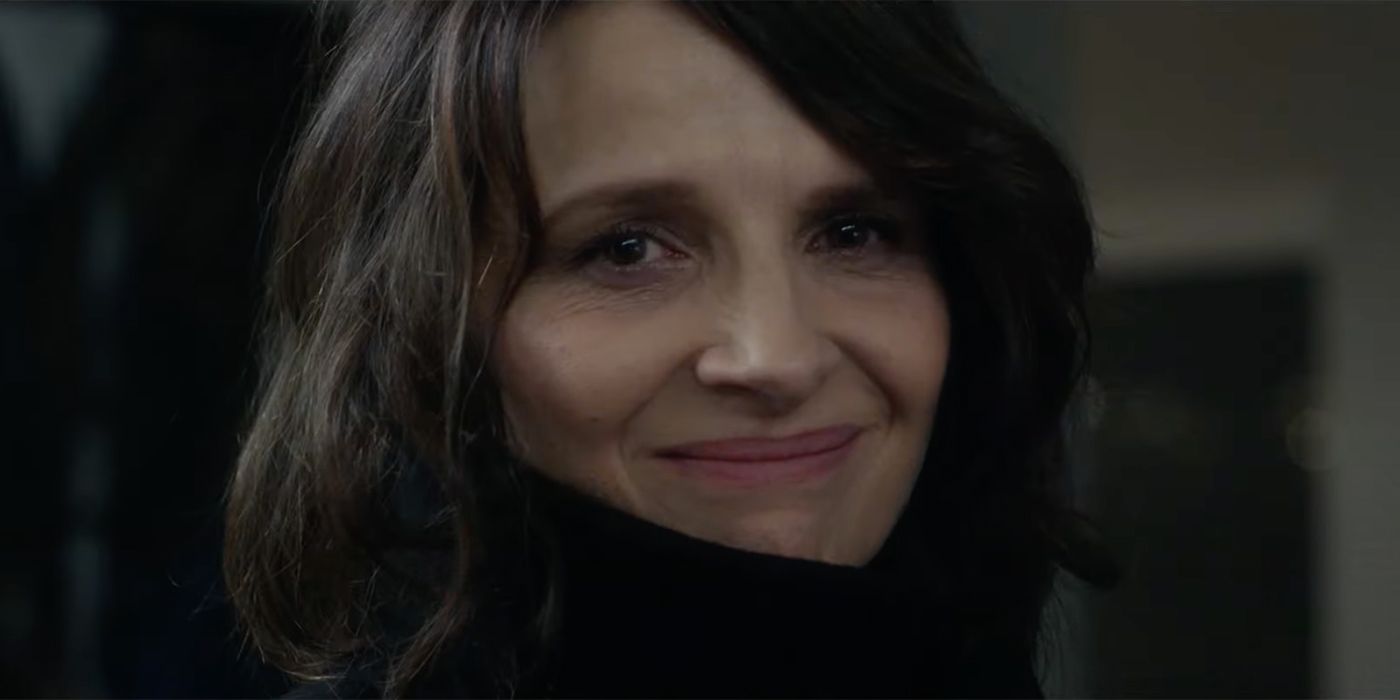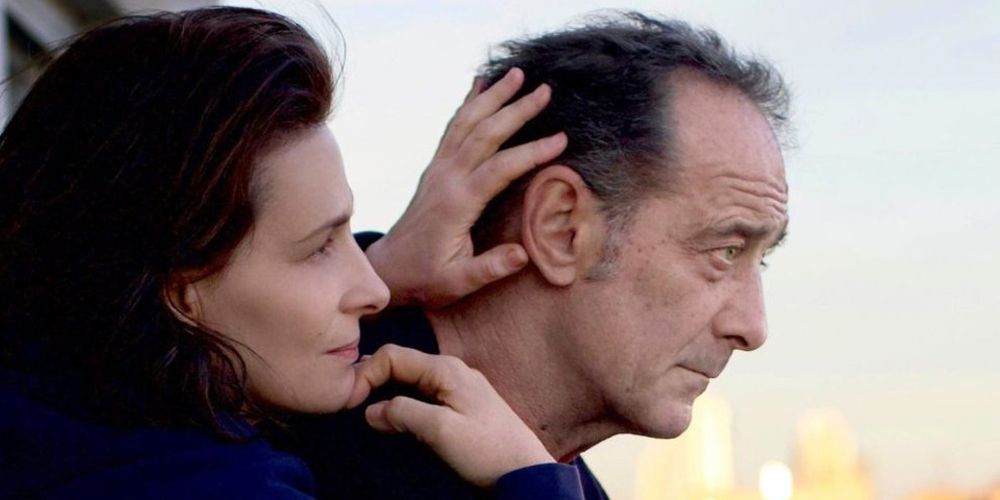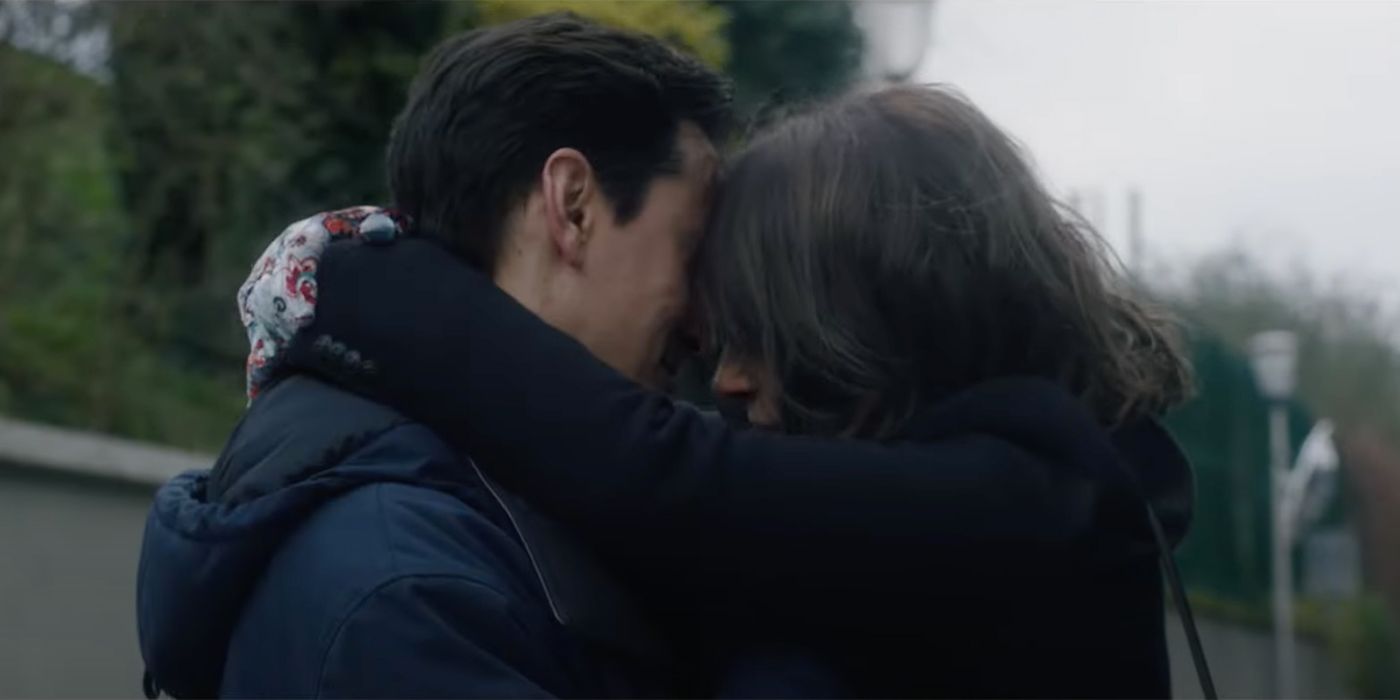In the striking opening scene of the barbed film that is Both Sides of the Blade, the latest work from writer-director Claire Denis, we are introduced to a couple caught in the throes of love. Placed in the scene as a delicate observer, we see Juliette Binoche’s Sara frolicking in the bright blues of the sea with Vincent Lindon's Jean. The sky is stunning, the setting sublime, and as they hold each other close, we are left with the feeling that these two people don’t have a care in the world. They are enraptured with each other, their faces relaxed and happy. It is a promising start that is imbued with a sense of impending dread by a somber score that is sprinkled throughout the rest of the film. When heard in this opening scene, there is the feeling that this is one of the last times we will see them happy. Proverbial storm clouds are gathering in the distance, threatening to drown the duo in a dour descent into discontentment.
You see, once the joyous vacation that Sara and Jean are on comes to an end, their subsequent return home draws out the worst of both of them. We now observe their day-to-day lives that are almost entirely devoid of the love and happiness from before. If we didn’t know any different, we would think these are different people whose relationship with the other is defined by disillusionment as opposed to passion. Denis places us in the confines of their apartment for much of the film, a well-directed framing of the scenes that traps us with the world’s most messy and melancholy couple imaginable. Gone are the vibrant colors of the sea as we are limited to a largely monochromatic world. It is a painfully claustrophobic space they inhabit, made even more so by the extreme close-ups of both their rather pained expressions. We get to see in precise detail their faces become increasingly drawn down by sadness. They squabble over seemingly small things that turn into a greater crisis, setting the stage for a film that submerges itself into the suffocating depths its characters fall into.
What follows is a thorny drama of sorts about a troubled love triangle, though that isn’t made central until the film is well underway. It is a slow burn whose flame occasionally flickers out, taking on the crushing coldness of the characters and making things often frigid as a result. It doesn’t burn nearly as bright as many of Denis’ other films, especially when compared to the horny and horrifying High Life that also starred Binoche. Generously, much of this can be attributed to the structure of the narrative itself. Much of the film is rather straightforward, drawing out the details of the story and its characters with a sense of solemnness that can almost feel aloof. As we learn, for instance, that Jean has served time in prison and also has a son that is living with his grandmother, it ought to carry greater significance in the story. Instead, Marcus (Issa Perica) can often feel like he is being used as a prop to greater explore the sins of his father. It isn’t the focus, though it frequently feels like not much is. What the film is interested in is far more elusive, gradually excavating a growing feeling of displeasure.
The conflict eventually comes with the arrival of Sara’s former lover François (Grégoire Colin) who wants to work with Jean. All three of the characters know each other, established in a story Sara tells to Jean that he seems to have forgotten. Yet, for all this history they supposedly have, the film rarely sees them all interacting together. Mostly they pair off, even having conversations off-screen that are then only recounted later. It creates a distance of sorts from the characters, a prism that refracts and distorts their depictions. They are both closed off from each other and us, hiding their true emotions until they burst out in explosive arguments. This elicits intense feelings when the isolation is broken apart, shattering it into a multitude of pieces that cuts through the facade of their lives. It is in these moments that the film really grabs you, pulling us in deeper to discover just how broken these people are. That is where both Binoche and Lindon get to rip into the material, elevating an experience that still lacks the same kinetic energy that it seemed like it was always grasping for.
For those that may expect this to be an erotic thriller, it isn’t really. This isn’t necessarily a bad thing, though it does feel like it needed more attention to detail to uncover something more substantive. There are a handful of sex scenes, though they are mostly just sad as opposed to sensual. One even sees Sara begin to break down, emitting a pained wailing that cuts deep and shows just how lonely she is. It is less about the spectacle and more about the way the tenuous existence she has built for herself may soon be torn apart. A brief monologue she gives to herself in the mirror, full of guilt and sadness, makes this explicit. The presence of the pandemic, seen in the masks worn by main and side characters alike, may speak to a greater societal loneliness that drives Sara to seek out connection as she does. Though this is not fully interrogated, instead playing out far in the background, leaving you to squint to fully see it. It is one of the many potential pieces of the film that soon struggle to come together.
What emerges is a work that is both chaotic at points and restraining in others. It stumbles into moments of occasional profundity, especially in the ending scene that really helps it coalesce, while also falling into the perils of the messy narrative. While it is important for the film to immerse itself in the emotional struggles of the scenes, it also is hindered by some occasionally abrupt edits and anarchic writing that dulls the sharpness of its story. The gawking at the messiness of it all becomes itself a kind of messiness, tangling up otherwise well-acted scenes to the point that they feel shallow. Though it finds strength in the extended moments of argument, when lacking a greater sense of purpose it becomes tarnished by a general tepidness that often takes hold. However, perhaps despite myself, there is much to still admire in how the film’s more compelling undercurrents will rear their head when you least expect them to. The more time that passed since watching it, the more this grew on me, a saving grace that was mostly able to ground down its flaws. What remains is a fraught film that, much like its characters, is in search of something more to provide meaning and connection. Though it never completely finds it, the journey along the way still leaves a mark.
Rating: B-
Both Sides Of The Blade comes to theaters on July 8.



